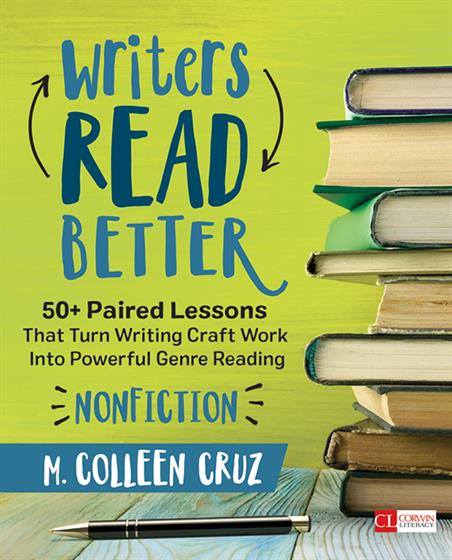List of Videos
Acknowledgments
Introduction
How to Use This Book
PART 1. LESSONS FOR GENERATING IDEAS—AND INTERPRETING AUTHOR’S PURPOSE
What You Will Find in This Section
When to Use These Lessons
Preparing to Use the Lessons
LESSON 1
Writing: An Author’s Expertise Matters
Reading: Considering the Source
LESSON 2
Writing: Write About What You Take for Granted
Reading: Learning Unexpected Things From Familiar Topics
LESSON 3
Writing: The Relationship Between an Author’s Passions and Stance
Reading: Identifying an Author’s Stance
LESSON 4
Writing: Narrowing Down a Broad Topic
Reading: Understanding Topics and Subtopics
LESSON 5
Writing: The Role of Structure in Informational Texts
Reading: Considering How Choices in Structure Affect Meaning
LESSON 6
Writing: Using Structure to Convey the Writer’s Intent
Reading: Inferring the Author’s Intent by Noticing Structure
FOR DIGITAL CLASSROOMS
Writing: Choosing the Best Platform for Your Information and Audience
Reading: Considering Why Authors Might Choose Analogue or Digital Mediums
PART 2. LESSONS FOR DRAFTING—AND UNDERSTANDING AUTHOR’S CRAFT
What You Will Find in This Section
When to Use These Lessons
Preparing to Use the Lessons
LESSON 7
Writing: Drafting What You’re Most Ready to Write
Reading: Spotting What’s Most Important to an Author
LESSON 8
Writing: Structure Within Sections: Stacking Information
Reading: Identifying the Way Information Is Stacked
LESSON 9
Writing: Drafting With Placeholders for Later Facts
Reading: Using Jots to Note Facts Quickly
LESSON 10
Writing: Taking a Draft Break to Research
Reading: Noticing the Various Ways Authors Use Quotation Marks
LESSON 11
Writing: Drafting With an Audience in Mind
Reading: Noticing the Different Genres of Various Publications on the Same Topic
LESSON 12
Writing: Drafting in a Mood or Tone That Matches the Content
Reading: Noticing When the Tone Doesn’t Match the Topic
LESSON 13
Writing: Drafting to Someone Else’s Specifications
Reading: Noticing a Publisher’s Approach
FOR DIGITAL CLASSROOMS
Writing: Fact-Checking Digital Information for Accuracy
Reading: Identifying False Information
PART 3. LESSONS FOR REVISING FOR POWER, CRAFT, ANALYSIS, AND CRITIQUE
What You Will Find in This Section
When to Use These Lessons
Preparing to Use the Lessons
LESSON 14
Writing: Deciding What’s Most Important to Revise
Reading: Identifying and Questioning the Author’s Values
LESSON 15
Writing: Reordering Information With Intention
Reading: Noticing the Effect of Information’s Placement
LESSON 16
Writing: Exploring How Writers Weight Information to Signal Import
Reading: Looking at Texts to See How Volume Can Signify Importance
LESSON 17
Writing: The Power of Story
Reading: Switching Strategies When Authors Use Story in Expository Text
LESSON 18
Writing: Connections and Disconnections Across Paragraphs and Pages
Reading: Tracing Connections and Disconnections in Transitions
LESSON 19
Writing: Vocabulary’s Starring Role in Informational Texts
Reading: Expecting and Responding to the Subject’s Vocabulary
LESSON 20
Writing: The Slipperiness of Facts
Reading: Reading With Eyes Wide Open for Bias
FOR DIGITAL CLASSROOMS
Writing: Adding Dimensions to Writing Through Multimodal Features
Reading: Multimodal Readers Prioritize Synthesis
PART 4. LESSONS TO PREPARE FOR PUBLICATION AND THE SCHOLARLY STUDY OF TEXTS
What You Will Find in This Section
When to Use These Lessons
Preparing to Use These Lessons
LESSON 21
Writing: First and Last Words: Intros and Conclusions That Attract and Linger
Reading: Studying an Author’s First and Last Words
LESSON 22
Writing: Choosing When to Quote, Describe, or Summarize
Reading: Identifying Sources and Considering Their Reliability
LESSON 23
Writing: Creating Text Features to Enhance and Add Information
Reading: Integrating Text Features Within and Across Texts
LESSON 24
Writing: Creating Strong Titles and Subtitles
Reading: Titles and Subtitles That Convey Meaning
LESSON 25
Writing: The Many Purposes of Paragraphs
Reading: Seeing Paragraphs as an Author’s Organizational Tool
LESSON 26
Writing: Punctuating With Intention
Reading: Looking Across Texts With an Eye to Punctuation
LESSON 27
Writing: Using Meaning to Make Smart Spelling Decisions
Reading: The Role of Etymology for Readers
LESSON 28
Writing: Making Publishing Decisions Based on the Intended Audience
Reading: Judging the Effectiveness of an Author’s Decisions
FOR DIGITAL CLASSROOMS
Writing: Opening and Maintaining a Conversation With Audiences
Reading: Responding Digitally to the Texts to Deepen Understanding
Publisher’s Acknowledgments
Resources
References
Index



